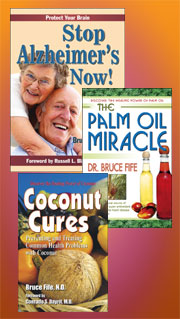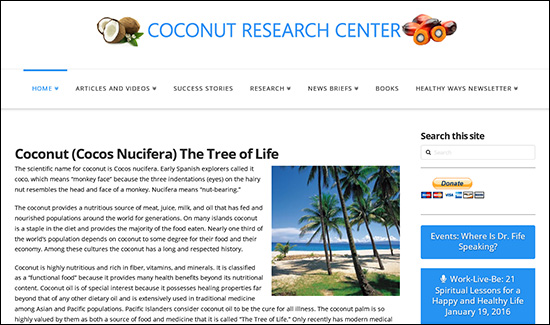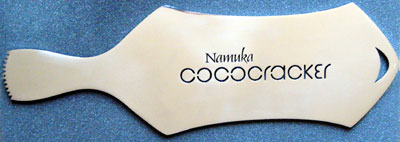|
E-Mail Edition Volume 9 Number 3 |
|||
|
Published Summer, 2012 Published by Piccadilly Books, Ltd., www.piccadillybooks.com. Bruce Fife, N.D., Publisher, www.coconutresearchcenter.org |
|||
|
If you would like to subscribe to the Healthy Ways Newsletter
|
Contents
|
||
|
Available from Piccadilly Books, Ltd.
|
Ask Dr. Coconut
Are there any studies or other reliable sources to back up the claims about the health benefits of coconut and palm oils? Do you have any scientific based information about the effects of coconut oil on heart disease or Alzheimer's?
Yes, there are many studies available. My books that address specific health issues are based on published medical studies. In the back of the books I list references to the studies cited in the text. Since everything in these books comes from studies or the historical record, the reference section typically contains hundreds of citations. In addition to the studies listed in my books, my website www.coconutresearchcenter.org contains a very extensive listing of coconut and palm oil studies. Look at the the navigation bar at the top of the page, (see example below).
Click the link labeled Research, then Medical Research. You then have the choice of Coconut Research or Palm Oil Research. Under Coconut Research you will find five major headings: coconut oil, coconut water, coconut meat/kernel, coconut milk, and coconut eating population studies. Under some of the headings you will find subheadings listing specific health concerns such as Cardiovascular Health, Diabetes, Cancer, Liver Health, Kidney Health, etc. Under each of these headings will be a listing of studies involving coconut. Each of the citations listed are linked to an abstract or full article so you can read more details about the studies. I am continually adding studies to these pages, so if you have been here before you will notice additional listings. The Coconut Research Center website is an excellent educational and research tool. It is by far the most extensive single resource on the health aspects of coconut and related products. I am continually adding information, so you should visit the site often to get the latest information about coconut. Another button on the homepage sidebar is "News Briefs." This is where you can find the latest news about coconut. Information includes newspaper and magazine articles as well as videos covering all aspects of coconut. For example, a recent addition was a video from the Good Morning America news program where Daphne Oz describes some of her own recipes using coconut oil. Daphne is the daughter of Dr. Mehmet Oz. Dr. Oz did several segments on his TV show about coconut oil; they are here too. There is even a video of the Muppets singing the song "I've Got a Lovely Bunch of Coconuts"—funny! You will also learn what pop star Madonna and I (Dr. Coconut) have in common. If you're interested in knowing the nutritional content of coconut milk or palm oil, the sidebar button "Nutrition Facts" takes you to a detailed listing derived from the USDA food database. You can find what vitamins, minerals, fatty acids, amino acids and other nutrients make up the various coconut and palm products. One of the most popular locations on the website is our "Success Stories" page, accessed through the button with that name. Here people post their own experiences using coconut oil and other coconut products and how they've overcome various health issues. Topics include arthritis, fibromyalgia, Alzheimer's, Crohn's disease, Candida, celiac disease, and more. People are continually adding their testimonies to this page. You are invited to share your success story. We would love to hear about it. The "Articles and Videos" button opens a page listing numerous informative articles about coconut and palm oils and dietary fats in general along with interviews and presentations on video. New articles and videos are continually being added. If you want to know about the agricultural aspects of coconut you will also find this information on the website. The sidebar on the right side of the home page links to two sources one titled "Coconut Growth, Development, and Management" produced by the Food and Agricultural Organization of the United Nations and the other titled "Basic Overview of Coconut Agriculture" produced by the University of Queensland, Australia. Just above these buttons is another button titled "A Coconut Oil Miracle." Here I tell my story about coconut and why I am so passionate about teaching everyone about this remarkable food. Visit the website often and use it as a tool to help educate your friends and family about the many wonders of coconut. ■
|
||
|
|
|||
|
|
Coconut Babies: The Secret to Raising Smart Kids
|
||
|
|
Over the past 12 years there has been a 17 percent increase in childhood developmental disabilities of all types including autism, attention deficit hyperactivity disorder (ADHD), epilepsy, mental retardation, and others. Currently in the United States, 4 million children have attention deficit hyperactivity disorder, the most common learning disability. Over 1 million people have autism. This number is rapidly growing. Over the past several years autism has increased to epidemic proportions. Thirty years ago it affected only 1 in 2,500; today 1 out of every 91 children in the United States has autism. According to a recent study in the journal Pediatrics, an incredible one in six children is now classified as learning disabled. Due to many factors, including changes in diet and lifestyle, children born today are at greater risk than previous generations of experiencing developmental delays and |
|
|
|
|
disorders. Despite this distressing trend, you can improve your chances of having intelligent, well behaved, healthy children. The key to accomplishing this comes from an unusual source—coconut, more specifically coconut oil. Mothers who have incorporated coconut products into their diets and their children's diets have been able to buck this trend in developmental disabilities. These children, so-called coconut babies, are born healthy physically and mentally and usually progress more rapidly than their peers. Fish is often been referred to a "brain food" because it contains omega-3 fatty acids that are needed for good brain health. While omega-3 fatty acids are necessary, coconut oil is rightly the ultimate brain food. What makes coconut oil so beneficial for the brain? The answer is its ability to produce ketones—a high potency fuel used by the brain. Normally, the brain uses glucose to satisfy its energy needs. If glucose is not available, one of the only other sources of fuel it can use is ketones. Other organs and tissues in the body can rely on fatty acids for energy if glucose in not available, but not the brain—it must have either glucose or ketones. Ketones actually provide a more concentrated and efficient source of energy than glucose. They have been described as our body's "superfuel," producing energy more efficiently than either glucose or fatty acids.1 Ketones can be produced from stored body fat when blood glucose levels become low or any time a source of medium chain triglycerides (MCTs) are consumed. Coconut oil is composed predominately of MCTs. Eating coconut oil stimulates the production of these brain-boosting ketones. When the brain has access to ketones it is like putting high performance gasoline into your car, the engine runs smoother, with more power, and less pollution. With ketones our brains function more efficiently. Ketones also activate special protective proteins known as brain derived neurotrophic factors (BDNFs). BDNFs exert survival-promoting and nourishing actions on brain cells and play a crucial role in brain cell function and survival. They regulate protein synthesis and neuron growth as well as influencing neurons' ability to make the neurotransmitters which allow the cells to communicate with each other. BDNFs also have a calming effect on inflammation and can help reduce chronic inflammation, which is a common feature in many neurological disorders such as autism. In older children and adults, ketones are used mostly to fuel brain cells along with functioning in the maintenance and repair of brain tissue. In young children, they are essential for growing new brain cells. The lipids (fats) that make up the majority of brain tissues are constructed from ketones. During pregnancy, a woman's ketone production increases sharply in order to supply the energy and building blocks required for her developing child's brain.2 Even when her blood glucose levels are normal, ketone production is elevated. The fetus doesn't rely solely on its mother's ketones, but produces them itself as well. After birth, the infant's blood ketone levels remain elevated as the brain continues to grow and develop. Ketones are most critical during the third trimester of pregnancy and for the first 26 months of life.3 This is the time of most rapid brain growth. An infant's brain increases in weight from 350 g (about 12 oz) at birth, to about 800 g (just over 28 oz) during the first year of life. By age two, another 400 g is added, giving it a total weight of 1,200 g. That's almost two pounds of brain in as many years! From this point on the brain increases in weight by only 200 g, so that by adulthood the brain weighs about 1,400 g. During this period of rapid growth, ketones are essential for building brain mass! Eating good sources of fat during pregnancy is important for the health of the baby as well as the mother. In many traditional cultures around the world women are encouraged to increase their fat intake to assure a healthy pregnancy. In Southeast Asian and the Pacific island communities it is the custom for pregnant women to add more coconut or coconut oil into their diets, especially during the last few months before delivery. It is their belief that coconut helps to make deliveries easier and the babies stronger and healthier. Over numerous generations they have witnessed how coconut oil protects both the mother and the developing child. In Malaysia coconut oil is used in late pregnancy for this same purpose. For generations Malaysian women have been encouraged to eat coconut oil while pregnant. Researchers at the Universiti Sains Malaysia medical school wanted to find out if this practice was just an old wives' tale or if it really offered some benefit. To answer this question they set out to find out if coconut oil consumption had an effect on infant mortality just prior to or soon after birth. They examined dietary and birth information from 316 mothers. They discovered that infants whose mothers had consumed coconut oil during pregnancy had a significantly higher survival rate, thus validating the age old practice.4 Consuming coconut oil during pregnancy not only increases the infant's chances for survival but can affect its health throughout life. Evidence suggests that children whose mothers eat coconut oil during pregnancy are less likely to become obese as adults.5 This effect is likely due to improved health of the mother which results in better fetal development. Defects in fetal development can affect the child's health for life. How much coconut oil should a pregnant woman be taking? Anywhere from 2-4 tablespoons a day, beginning with the first indication that she is pregnant or as soon as she plans to become pregnant. Of course, coconut oil offers so many health benefits that it is a good idea to be taking some every day whether you plan to become pregnant or not. The oil should be added slowly into your diet, especially if you are already pregnant. If you are not accustomed to eating much fat, the added fat may cause a bit of nausea or diarrhea. If you consume the oil with food, these symptoms are less likely to happen. Start off slowly with 1 tablespoon or less per day. Divide the dose up between each of your meals. Over time gradually increase the dosage until you are able to take 3 or more tablespoons of coconut oil daily without problem. After delivery, mothers should continue eating 2-4 tablespoons of coconut oil because it will greatly improve the quality of their breast milk. Fat is a major component of mother's milk. It supplies about 50-60 percent of the calories in breast milk. Breast milk generally contains between 2-20 percent MCTs depending on the mother's diet. Adding coconut oil to the diet can increase the milk's MCT content to around 20 percent or more. The MCTs are important because they are readily converted into ketones by the infant's liver. In the first few weeks of life, ketones provide about 25 percent of the energy newborn babies need to survive and supplies the building blocks for continued brain growth. MCTs from coconut oil provide other benefits beyond their ability to produce ketones. MCTs are included in hospital infant formulas to serve as a primary source of energy for premature infants. They are used in feeding formulas given to patients recovering from surgery and those with malnutrition and malabsorption problems.6 One of the advantages of MCTs over the more common long chain triglycerides (LCTs) found in most all other oils is their speed and efficiency in digestion. LCTs require pancreatic digestive enzymes and bile in order to break down into individual fatty acids. MCTs, on the other hand, break down so quickly that they do not need pancreatic digestive enzymes or bile, thus reducing stress and conserving the body's enzymes. The digestive systems of young infants are still maturing and LCTs put a great deal of strain on their bodies. LCTs are often incompletely digested and, therefore, do not provide their full nutritional potential. Not so with MCTs. Consequently, MCTs provide a superior source of energy and nutrition to infants than do LCTs. Premature and underweight infants are particularly vulnerable to nutritional deficiencies. Their digestive systems cannot assimilate nutrients, especially LCTs, as effectively as normal weight babies. Adding coconut oil or MCTs to hospital infant formulas has greatly improved these children's nutritional status and their chances for survival.7-9 The difference in the way MCTs are digested is of great interest in medicine because it provides a means by which a number of medical conditions can be successfully treated. Replacing a portion of the LCTs normally found in the diet with MCTs has allowed doctors to successfully treat a variety of malabsorption syndromes in children including defects in fat digestion and absorption, pancreatic insufficiency, liver and gallbladder disorders, defects in protein metabolism, cystic fibrosis, and celiac disease.10-16 MCTs can even speed recovery after intestinal surgery.17 Since the 1970s coconut oil or MCTs have been added to hospital infant formulas. In fact, they are also included in the feeding formulas given to hospital patients of all ages. Studies have shown that when MCTs are added to nutritional formulas, patients recovering from surgery or illness get better faster.18-20 Coconut babies—the children of mothers who consumed coconut oil while pregnant and nursing—eat better, sleep better, and grow faster. Common health problems such as colic and thrush are dramatically reduced, as are developmental disorders such as ADHD and autism.21 Mothers of coconut babies often have quicker and easier deliveries. When nursing is discontinued, there usually is no other significant source of MCTs in the baby's diet so ketone production declines dramatically. This can have a significant impact on brain growth and development and overall health. This is one of the reasons why mothers are encouraged to continue nursing for at least 12 months and up to two years. This is also one of the reasons why coconut oil, a natural source of MCTs, is added to all commercial infant formulas. Our brains, like our bodies, need good nutrition to be healthy. Studies show that poor nutrition in the first few years of life leads to lower IQ as well as antisocial and aggressive behaviors.22 Intellectual performance declines with the severity of malnutrition. Even moderate malnutrition affects memory, verbal reasoning, comprehension, visual perception, and visual motor integration.23 Malnutrition can occur due to a lack of food (total calories) or to a deficiency in essential nutrients—protein, fat (including MCTs), minerals, and vitamins. A diet of poor quality foods can provide ample calories but still be nutritionally deficient. Such a diet can be deceiving because a child can be normal weight or even overweight, yet still suffer from malnutrition due to a vitamin or mineral deficiency. For a child's brain to reach its full genetic potential it needs good nutrition. Some children have difficulty absorbing the nutrients in their foods due to various malabsorption problems. Often parents are unaware that such problems exist and don't understand why their children are undersized, fail to thrive, or display developmental delays. If the problem is severe it is likely to be diagnosed early on. If the problem is less pronounced, it may never be identified. If the child had a developmental disability, malnutrition can compound the problem. Coconut oil can help. An interesting study was done by researchers at Auburn University. They fed lab animals a vitamin B deficient diet leading to beriberi—a fatal vitamin B-1 (thiamine) deficiency disease. However, when coconut oil was added into the diet it prevented the disease. Coconut oil does not contain vitamin B-1, so it did not supply the missing nutrient directly. What it did was make what little vitamin B-1 that was already present more absorbable, thus supplying enough of the nutrient to prevent the disease.24 Other oils did not have this same effect. A number of studies have found that coconut oil improves the absorption of not only the B vitamins but also vitamins A, D, E, K, beta-carotene, lycopene, CoQ10, and other fat soluble nutrients, minerals such as calcium, magnesium, and some amino acids—the building blocks for protein.25 What this means is that if you add coconut oil to a meal, you will get significantly more vitamins, minerals, and other nutrients out of the food than if you used any other oil or no oil at all. Simply adding coconut oil to a meal greatly enhances the food's nutritional value. This fact has led researchers to investigate the use of coconut oil in the treatment of malnutrition. Studies have shown coconut oil to be superior to other oils, leading to greater growth and weight gain in malnourished children.26 |
||
|
|
To maintain all the benefits of MCTs after weaning, you should add coconut oil to your child's food. As a general guideline, normally developing children can be given 1 teaspoon of coconut oil for every 15 pounds of body weight. A child with developmental problems may need twice this amount. Don't give the total daily amount all at one time. Divide it into equal portions and mix it into the food given throughout the day. Keep in mind that coconut oil is a food and, therefore, is not toxic even in large doses; however, too much at any one time may increase the frequency of bowel movements. Taking coconut oil regularly while pregnant will greatly improve your changes of giving birth to a healthy, full-term, intelligent child. Eating coconut oil while nursing and feeding it to your baby after weaning will provide nutritional support for continued mental and physical growth and development. ■ |
Learn how coconut oil can improve your child's mental and emotional development.
|
|
|
References 1. Liu, Y.M., et al. A prospective study: growth and nutritional status of children treated with the ketogenic diet. J Am Diet Assoc 2003;103:707-712. 2. Hawkins, R.A. and Biebuyck, J.F. Ketone bodies are selectively used by individual brain regions. Science 1979;205:325-327. 3. Wu, P.Y., et al. Medium-chain triglycerides in infant formulas and their relation to plasma ketone body concentrations. Pediatr Res 1986;20:338-41. 4. Ab Rahman, A., et al. The use of herbal medicines during pregnancy and perinatal mortality in Tumpat District, Kelantan, Malaysia. Southeast Asian J Trop Med Public Health 2007;38:1150-1157. 5. Dong, Y.M., et al. High dietary intake of medium-chain fatty acids during pregnancy in rats prevents later-life obesity in their offspring. J Nutr Biochem 2011;22:791-797. 6. Jiang, Z.M., et al. 1993. A comparison of medium-chain and long-chain triglycerides in surgical patients. Ann. Surg. 217(2):175. 7. Vaidya, U.V., et al. 1992 Vegetable oil fortified feeds in the nutrition of very low birthweight babies. Indian Pediatr. 29(12):1519. 8. Tantibhedhyangjul. P. and Hashim, S.A. Medium-chain triglyceride feeding in premature infants: effects on fat and nitrogen absorption. Pediatrics 1975;55:359-370. 9. Roy, C.C., et al. Correction of the malabsorption of the preterm infant with a medium-chain triglyceride formula. J Pediatr 1975;86:446-450. 10. Burke, V. and Danks, D.M. Medium-chain triglyceride diet: its use in treatment of liver disease. Brit Med J 1966;2:1050-1051. 11. Kuo, P.T. and Huang, N.N. The effect of medium chain triglyceride upon fat absorption and plasma lipid and depot fat of children with cystic fibrosis of the pancreas. J Clin Invest 1965;44:1924-1933. 12. Cancio, M. and Menendez-Corrrada, R. Absorption of medium chain triglycerides in tropical sprue. Proc Soc Exp Biol (NY) 1964;117:182-185. 13. Isselbacher, K.J., et al. Congenital beta-lipoprotein deficiency: an hereditary disorder involving a defect in the absorption and transport of lipids. Medicine (Baltimore) 1964;43:347-361. 14. Holt, P.R. Dietary treatment of protein loss in intestinal lymphangiectasia. Pediatrics 1964;34:629-635. 15. Greenberger, N.J., et al. Use of medium chain triglycerides in malabsorption. Ann Internal Med 1967;66:727-734. 16. Tantibhedhyangkul, P. and Hashim, S.A. Medium-chain triglyceride feeding in premature infants: effects on fat and nitrogen absorption. Pediatrics 1975;55:359-370. 17. Zurier, R.B., et al. Use of medium-chain triglyceride in management of patients with massive resection of the small intestine. New Engl J Med 1966;274:490-493. 18. Wang, X., et al. Enteral nutrition improves clinical outcome and shortens hospital stay after cancer surgery. J Invest Surg 2010;23:309-313. 19. Ball, M.J. Parenteral nutrition in the critically ill: use of a medium chain triglyceride emulsion. Intensive Care Med 1993;19:89-95. 20. Wang, X.Y., et al. Effect of high amounts of medium chain triglyceride and protein enteral nutrition on nutritional status in patients after major abdominal operation. Zhonghua Wei Chang Wai Ke Za Zhi 2007;10:329-332. 21. Fife, B. Stop Autism Now! A Parent's Guide to Preventing and Reversing Autism Spectrum Disorders. Piccadilly Books, Ltd.:Colorado Springs, CO, 2012. 22. Liu, J., et al. Malnutrition at age 3 years and externalizing behavior problems at ages 8, 11, and 17 years. Am J Psychiatry 2004;161:2005-2013. 23. Upadhyay, S.K., et al. Influence of malnutrition on intellectual development. Indian J Med Res 1989;90:430-441. 24. Salmon, W.D. and Goodman, J.G. Alleviation of vitamin B deficiency in the rat by certain natural fats and synthetic esters. Journal of Nutrition 1936;13:477-500. 25. Tantibhedhyangkul, P. and Hashim, S.A. Medium-chain triglyceride feeding in premature infants: effects on fat and nitrogen absorption. Pediatrics 1975;55:359-370. 26. Intengan, C.L., et al. Structured lipid of coconut and corn oils vs. soybean oil in the rehabilitation of malnourished children—a field study. Phil J Internal Medicine 1992;30:159-164.
|
|||
|
|
|||
|
|
Smart Babies Stay in Womb Longer Even for infants born full-term, a little more time in the womb may matter. The extra time results in more brain development and better scores on academic tests later in life.
One of the strongest indicators of an infant's future health is its birth weight. Children who are born premature or underweight are more prone to health problems later in life, score lower on IQ tests, and perform poorer in school. Children who are born prematurely have higher rates of cerebral palsy, sensory deficits, learning disabilities, and respiratory illnesses compared with children born at term. Underweight is defined as weighing under 5½ pounds (2.5 kg) at birth. A premature birth is defined as one that takes place before 37 weeks of gestation. A normal pregnancy usually lasts for 40 weeks. This is the number doctors use to estimate due dates. The closer to the 40 week delivery date the better, but a safe delivery is generally considered any time between 37 to 41 weeks. A recent study, however, has found that delivery just two or three weeks before the 40 week due date can affect the infant's health and mental development. Researchers at Columbia University Medical Center in New York City aimed to find out whether there were differences in third grade reading and math scores among 128,000 children considered to have been born within a "normal" gestational range between 37 and 41 weeks. What they found was that those born at 37 weeks and 38 weeks had significantly lower reading scores compared to children born at 39, 40, 41 weeks. Math scores were also lower for children born at 37 to 38 weeks. Compared with 41-weekers, children born at 37 weeks faced a 33 percent increased chance of having severe reading difficulty in third grade and a 19 percent greater chance of having moderate problems in math. These outcomes are critical and predict future academic achievement. The researchers said the results suggest that the definition of prematurity should be revised. |
||
|
|
The finding also raises questions about hastening childbirth by scheduling early full-term deliveries for convenience—because women are tired of being pregnant or doctors are busy—rather than for medical reasons. At 37 or 38 weeks some women may ask for elective C-sections or induction of labor, or attempt natural induction methods at home. "The finding should give parents-to-be pause before opting for early birth for non-medical reasons," says lead author Dr. Kimberly Noble. "The data suggest that children born at 37 or 38 weeks may have problems with reduced school achievement later on." She added, "Until we have more data we would encourage parents and physicians to exercise caution when considering elective induction of birth prior to 39 weeks gestation." Once a pregnancy has reached 37 weeks the thinking has been, "This is no big deal—the baby is full-term." According to statistics from the US Centers for Disease Control and Prevention, such births appear to be a growing trend. Only 9.5 percent of all births in 1990 were through elective induction. Compare that to 2007, which saw nearly 23 percent of all births electively induced. This trend is not limited to the US, but is seen throughout the world. During the final trimester of pregnancy the brain undergoes rapid growth. A child born at 36 weeks and 6 days (just prior to the 37 week definition of full-term) has a brain size only two-thirds that of a 40 week infant. The brain is still underdeveloped. One day more isn't going to make much difference. "The brain continues to grow rapidly during this time, with a nearly 50 percent increase in cortical gray matter, a nearly three-fold increase in myelinated white matter, and increasing neuronal and gyral differentiation," says Dr. Noble. Sometimes early delivery is warranted for medical reasons. What can parents do to assure that their children have the best opportunity to develop normally? Coconut oil offers one possible solution. Since the MCTs in the oil are converted into brain enhancing ketones, adding the oil into |
Infection During Pregnancy Tied to Autism Risk
Researchers at the University of California, Davis recently reported that having an infection and fever during pregnancy is associated with an increased risk of autism spectrum disorders and developmental delays in the offspring. Previous research has suggested a connection between autism and various infections during pregnancy, including measles, mumps, rubella and influenza. In this new analysis, researchers studied 701 children with autism spectrum disorders or developmental delays and 421 normal controls. After adjusting for age and other health and socioeconomic variables, they found that women who reported having had a fever during pregnancy were more than twice as likely as those who did not to have a child with a developmental disorder. Among women whose fever had been treated with drugs like Tylenol or Advil, the risk was indistinguishable from that of mothers who reported no fever. "Fever is an acute inflammatory response," said the senior author, Irva Hertz-Picciotto, a professor of environmental epidemiology at the Mind Institute of the University of California, Davis. "So there is a suggestion that inflammation of some sort may play some role in autism causation. Untreated fever seems to be the place where the risk is." Earlier studies have shown that inflammation in the mother can trigger an inflammatory response in the fetus. Inflammation, particularly repeated or chronic inflammation, can affect the development of the fetal brain increasing the risk of developmental disorders. The connection between inflammation and its relationship to autism is explained more fully in the book, Stop Autism Now! A Parent's Guide to Preventing and Reversing Autism Spectrum Disorders. See link above.
Source: Zerbo, O, et al. Is maternal influenza or fever during pregnancy associated with autism or developmental delays? Results from the CHARGE (CHildhood Autism Risks from Genetics and Environment) Study. Journal of Autism and Developmental Disorders, Online First, 5 May 2012.
|
|
|
|
the mother's diet can have a significant effect. Coconut oil consumption will help the fetal brain develop faster and will improve both the mother's and baby's health, reducing the risk of premature delivery. Mothers should be eating coconut oil during pregnancy and while nursing. For more information about how coconut oil can enhance your child's language, math, and social skills, IQ, behavior, and overall health, see my book Stop Autism Now! While this book focuses on autism, it explains what parents can do to prevent and reverse developmental disorders and enhance their children's mental and overall health.
Source: Noble, KG, et al. "Academic achievement varies with gestational age among children born at term." Pediatrics July, 2012. ■
|
||
|
|
|||
|
|
Deadly Flesh-Eating Bacteria Succumb to the Power of Coconut Oil
After nearly two months of intensive care, Aimee Copeland was released from the hospital to start rehab. Just a few weeks earlier she was on life support struggling to survive. Aimee, a 24-year-old Georgia graduate student, was kayaking with friends when the accident happened. As a diversion, they decided to make a homemade zip line. An equipment malfunction on the zip line caused Aimee to fall and cut her leg. The injury was not that serious but it became infected with necrotizing fasciitis, also known as flesh-eating bacteria. The infection spread quickly, eating away tissues throughout her body. Within days Aimee was battling for her life. She suffered with the failure of five major organs including her lungs and kidneys. To save her life doctors had to amputate her left leg, right foot, and both of her hands. Aimee was one of the lucky ones. Necrotizing fasciitis is a severe bacterial infection that causes death in 1 out of every 3 cases. The infection is caused by so-called flesh-eating bacteria because it spreads rapidly destroying skin, muscles, and underlying tissues. The decaying flesh appears as if being eaten by the bacteria. The word "necrotizing" refers to something that causes body tissues to die. As the bacteria grow, toxins are released that kill tissues and interfere with blood flow to the infected area. As the tissue dies, the bacteria enter the blood and rapidly spread throughout the body.
Flesh-eating bacteria attacking a patient's leg.
Treatment consists of broad-spectrum antibiotics given intravenously. Surgery is often needed to drain the sore and remove dead tissue. Skin grafts and amputation may be necessary if the disease spreads through an arm or leg. There's no single kind of flesh-eating bacteria, many bacteria can be the cause. However, methicillin-resistant Staphylococcus aureus bacterium or MRSA causes a particularly nasty form of the disease because it is resistant to antibiotic therapy, making it very difficult to treat. The medium chain fatty acids (MCFAs) in coconut oil possess antibacterial properties and are known to kill Staphylococcus aureus bacterium, including the drug resistant MRSA. Can coconut oil be used effectively to treat bacterial infections? Many people have reported good results treating various infections in both themselves and their pets. In some cases, only coconut oil is used. In other cases, a combination of antibiotics and coconut oil has been successful. Clinical studies have shown that when used with conventional therapy coconut oil can often speed recovery. Some of the most remarkable cases we hear about come from pet owners. Recently, I received a note from the owner of Natural Pet Essentials. She related an incident that happened to one of her customers involving a Golden Retriever who had a recurring bacterial infection in his paw, and when they did a culture, they discovered that it was MRSA. Here is her story: "In December 2011, my Golden Retriever was outside playing and cut the bottom of her paw. I was not aware of this until she began licking to heal what had already become infected. I took her to the veterinarian and he began her on a 28-day course of antibiotics. I cared for the paw by soaking it in Epsom salts 2-3 times a day and applying antibiotic cream and a clean dressing. When the course of antibiotics was complete, we still had an infected paw. She was again put on a 14-day course of medication. At that point, I was not seeing any response from the antibiotic so I consulted our veterinarian. He decided to take a culture of the area. It came back as MRSA! I was panicked. My option was one—to put her on the only known dose of antibiotic that would treat the infection. I was warned that this could be deadly. I refused the treatment. "I stopped in at Natural Pet Essentials, and I am sure glad I did. The knowledge that Kim had was incredible. She asked me to try coconut oil, since it is known to heal. I thought about it for all of one second and knew a natural remedy would be great if it would actually work. Let me just say: "It worked!" I was amazed in as little as 3-4 days that her paw was looking much better and beginning to heal. The veterinarian was amazed also. I am now a permanent user of coconut oil and coconut chips for both of our dogs. Rylee, my Golden Retriever, is now a healthy and very happy 3-year-old Golden with a lot of spunk and willingness to play. If I had continued down the path of conventional veterinary medicine, I don't know if I would have my beautiful girl today. I am not saying that veterinary care is not good or important, I am just advising those with pets to look into other natural sources before giving in to [conventional veterinarian] medicine." ■
|
||
|
|
|||
|
|
New Study Shows Virgin Coconut Oil Improves Cholesterol Levels
A clinical study out of the University of Santo Tomas (UST), Philippines, has shown that eating virgin coconut oil (VCO) produces beneficial effects on triglyceride and cholesterol levels. The research team led by Dr. Christina Binag of the UST Research Center for Natural and Applied Science said the double-blind study, where both researchers and subjects were not aware of who were taking VCO and the placebo, showed decreases in triglycerides and improved the cholesterol ratio, both indicators of reduced risk of cardiovascular disease. Commissioned by the Philippine Coconut Authority, the study required 110 participants to take 3 tablespoons of VCO every day for four months while 79 others took a placebo for the same period. Dr. Binag said this was the largest clinical study ever undertaken on the effects of VCO on cholesterol levels. Results indicated that among the VCO takers decreases in triglycerides and very low density lipoprotein (VLDL)—a form of the so-called "bad" cholesterol. They also showed elevated high density lipoprotein (HDL), which is known as the "good" cholesterol. Higher levels of HDL cholesterol is known to reduce the risk of heart attacks and strokes. No changes were seen the lipid profile of the placebo group. Other changes were also noted by the researchers, stating, "There was an unexplained rise in creatinine but still within the normal range. Elevations in Free Thyroid 3 and Free Thyroid 4 were noted due to enhanced thyroid function. No change was noted with BMI (body mass index) and weight." Aside from these clinical effects, the group also reported that those who took the VCO felt stronger and healthier. They reported regular bowel movements, increase in appetite and stamina, and better sleep with regular VCO intake of 3 tablespoons a day. Apart from keeping cholesterol levels under control, improving thyroid function, and boosting energy levels, three spoonfuls of virgin coconut oil may also enhance a person's sex life. Some members of the group reported that they were more virile during the test phase. "It was an interesting observation that 13 percent of the VCO takers experienced becoming sexually active in the whole duration of their participation in the VCO study," the team said. This study provides further evidence that virgin coconut oil is not only heart healthy but may provide additional health benefits as well. ■
Reference: Scientists Present Results of Clinical Study on VCO — Philipines. Cocommunity 1 May, 2012, Vol 42, No 4, pp7-8.
|
||
|
|
|||
|
The Cococracker
Do you have trouble opening hard mature coconuts? Do you find it difficult to extract the meat and remove it from the shell? Do you want to make your own shredded coconut? It's possible with the Cococracker. The Cococracker is a multipurpose tool designed to crack open coconuts and scrape out the meat.
The tool is made in Germany out of high quality stainless steel. It is made from a single flat piece of steel, about 1/8-inch thick. It is practically indestructible and will last a lifetime and probably the lifetime of your kids as well. The tool is produced by Namuka Partyservice, a Fijian party service located in Germany. The company is owned by Manika and Birgit Matanisiga, a husband and wife team, one from Germany the other from Fiji. To use the Cococracker you hold it in one hand, much like you would a meat cleaver. In the other hand you hold a mature brown coconut. While holding the coconut you hit it with the Cococracker, splitting it into two relatively equal pieces. If you have a strong arm and a good aim, it only takes one or two strikes to crack open the coconut.
The Cococracker
|
|||
|
|
Once the coconut is opened, you need to remove the meat. One end of the Cococracker has a sharp scraper. You place the Cococracker flat on a chair and sit on it to hold it in place. Place a large bowl on the floor between your feet. Taking half a coconut you scrape the meat out of the shell and into the bowl. The shredded meat can be eaten as is, used in cooking, or used to make fresh coconut milk. You can watch a video of the whole process here. The Cococracker is rather heavy, it weighs 3 pounds (1.36 kg). In comparison, a good quality hammer only weighs about 2 pounds (1 kg). Because of its weight and flat design (which made it uncomfortable for me to hold), I found it a bit difficult to use. It definitely takes some practice! For more information about the Cococracker go to: https://www.facebook.com/Namuka-Partyservice-125394187480355/ .
|
Scraping the meat out of a coconut.
|
|
|
|
|||
|
Do you have friends who would like this newsletter? If so, please feel free to share this newsletter with them.
If this newsletter was forwarded to you by a friend and you would like to subscribe, click here.
Copyright © 2012, Bruce Fife. All rights reserved.
|
|||









